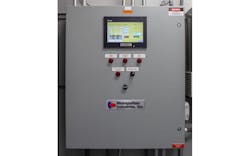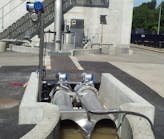Starting from scratch meant we were able to take a step back, address the current limitations as well as consider Romeoville’s needs today and in the future, and design a lift station that would be poised to grow with the community for at least another 50 years. First and foremost, that meant moving the location of the station a few hundred feet away to allow for a larger wet well and the development of a totally new system.
In an effort to provide significant improvements, the new location allowed for significant added features. For one, we installed safety grates on all hatches to eliminate fall risks, but safety was only part of the goal. We also knew that building a new system in a new location would offer the opportunity to take advantage of better technology and, to prepare the new equipment to withstand the round-the-clock demands of a busy industrial park, we used an advanced coating, polyurea, to protect the wet well and valve vault. We also increased the number of pumps from two to three and installed pumps with greater capacity than the original lift station to allow the new location to accommodate future growth and help the municipality better handle the infiltration issues they’d been facing until a more permanent remedy is put in place. While the old system was significantly surcharged, risking backflow to users, the new setup is equipped to help alleviate old shortcomings.
Standing Out by Blending In
To provide the new lift station with all the controls necessary to keep it up and running, we also constructed a prefabricated building. The exterior features the stone finish that is now the standard exterior for Romeoville’s municipal utility buildings (a second structure of this design—and others may be forthcoming) and the interior keeps operators out of the elements when maintenance work is needed.
We also tried to keep both emergency and routine work in mind by including features such as flow meters on each pump in the valve vault to help operators monitor the efficiency of each pump. As an added benefit, a backup generator is now part of the station, eliminating the need for trailering a generator to the site in anticipation of potential lost power. All of this new equipment is also connected via cellular data through Metropolitan’s MetroCloud SCADA, so the municipality can remotely monitor just about every aspect of operation, including temperature, humidity, generator use, and people entering the building.
Editor's Note: Scranton Gillette Communications and the SGC Water Group are not liable for the accuracy, efficacy and validity of the claims made in this piece. The views expressed in this content do not reflect the position of the editorial teams of Water & Wastes Digest, Water Quality Products and Storm Water Solutions.




